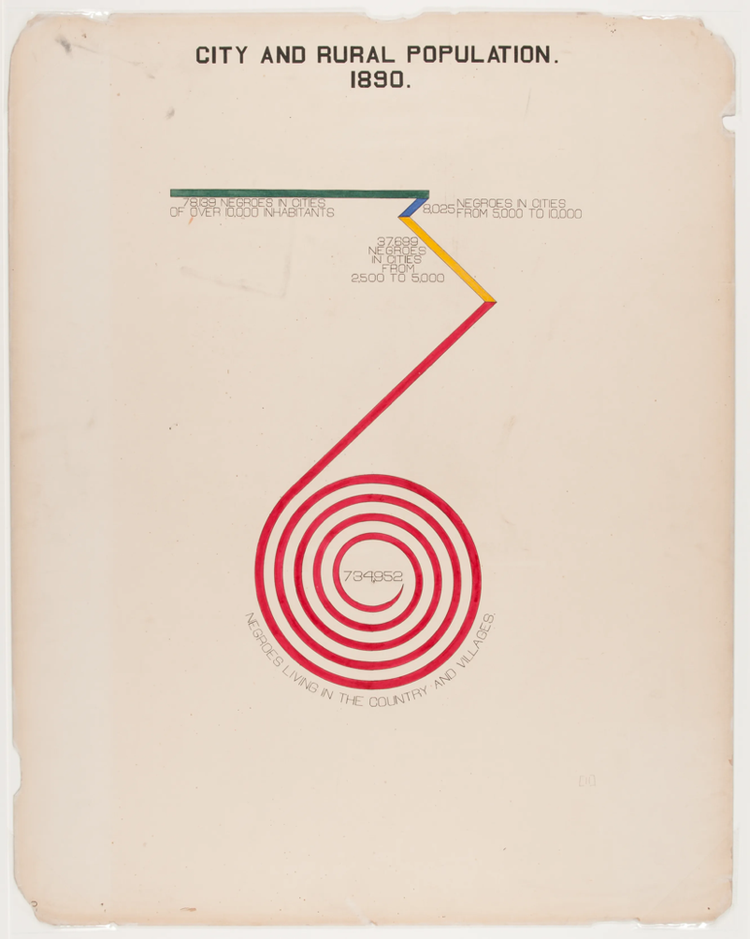Black Graphic Design History: Influence and Impact

When delving into the history of Black graphic design, you swiftly come to a recurring message: Black graphic designers are a staggering quantitative minority. Despite rich contributions from designers past and present, the 2021 AIGA Design POV reported that only 4.9 percent of counted graphic designers are Black. A variety of scholarship has sought to make sense of this scarcity, catalogue and bring light to their experience in the field, as well as establish a robust understanding of Black aesthetics. Among these contributions are Dorothy Jackson’s The Black Experience of Graphic Design, published in Print in 1968 with reflections from many living Black designers in 2020, Cheryl D. Holmes-Miller's 1987 piece Black Designers: Missing in Action in Print and its 2016 and 2020 follow-up pieces, and Sylvia Harris’ Searching for a Black Aesthetic in American Graphic Design. They are of course not alone.
How then, in the context of such scarcity and the obstacles of discrimination and lack of opportunity, do we present an accurate and encompassing history of Black graphic design? The cohort contains a range of aesthetics, politics, viewpoints, and individuals. This history of Black graphic design aims to acknowledge the influence and impact that Black graphic designers have brought to the field, while honoring the inherent diversity of the artists and creators involved.
This blog post is the first in a series where we’ll highlight key time periods and individuals who have shaped our contemporary understanding of Black graphic design, and the field as a whole. Check out the Adobe Express blog in the coming months for parts two and three of our Black graphic design history.
Part 1: The Early 20th Century and the Harlem Renaissance
At the turn of the 20th century, the grip of Jim Crow laws and upholding of segregation catalyzed a new wave of Black political resistance and the Great Migration, which saw masses of Black Americans fleeing the South for cities in the Northeast and Midwest. Alongside political activation and the influx of Black Southerners to urban areas came cultural efforts in literature, art, and music, among other forms that collectively would become the New Negro Movement, later named the Harlem Renaissance.
While Harlem was one cultural center of this activity, cities like Chicago, Pittsburgh, and Philadelphia would also have flourishing scenes of their own. The three creators featured here were active in and around the period — certainly differing in their contributions but aligned in charting a new course for Black design.
Charles Dawson
Charles Dawson was active as a commercial artist during the 1920s and 1930s, creating advertising and editorial illustration. His work for Chicago cosmetics companies Valmor and Black-owned Overton featured beauty schools and products that showcased Black beauty. Valmor owner Morton Neumann forbid Dawson from signing his work, which meant that he wasn’t credited until years later.

In 1933, Dawson self-published the children’s book ABCs of Great Negroes, which featured bold linoleum-cut portraits and short biographies of notable Black people throughout history, including Nefertiti, Frederick Douglass, and Haitian revolutionary general Toussaint Louverture.

Charles Dawson, Poster for “O Sing a New Song,” ca. 1933
Dawson’s presence would also take hold in exhibitions. He was the only Black artist to show in the 1933–1934 Chicago World’s Fair, having created a mural for the National Urban League’s exhibition of the Great Migration of Black people from the American South to Northern industrial cities. His poster for “O Sing a New Song” — a Black music pageant in conjunction with the fair — is one of his most circulated images. These works stand out for being positive representations of Black people at the World’s Fair. During this period, most graphics featuring Black people relied on lazy, racist, and harmful visual tropes. Juxtaposing Dawson’s work with the common, crude, and stereotypical depictions from that era makes his point-of-view even more powerful.
In addition to his work as an artist, Dawson also participated in arts organizing and curation, enabling him to promote other Black artists. This work includes co-founding the Arts and Letters Society (the first Black artist collective in Chicago) and establishing the Chicago Art League, a group of exhibiting Black American artists. He would later become the Curator at the Museum of Negro Art and Culture at the Tuskegee University in Alabama.
Aaron Douglas
Hailed by some as the “Father of Black American Art,” illustrator and artist Aaron Douglas was a key figure in the Harlem Renaissance.
Born in Kansas, Douglas spent his early years in the Midwest, building up a reputation that would eventually garner the attention of sociologist and editor Charles Spurgeon Johnson, among others. He arrived in New York in 1925, just months after the Harlem: Mecca of the New Negro issue of Survey Graphic was released. Douglas would later be linked through Johnson to German Art Deco artist Fritz Winold Reiss, who produced images for that issue and would take on Douglas as an apprentice.
Douglas’ characteristic style emerged with a blend of influences behind it. Reiss and Alain Locke, an intellectual leader and the “Dean” of the Harlem Renaissance, were among those who encouraged Douglas to look to his African heritage for visual inspiration.
In the late 1920s, Douglas designed covers for writer Wallace Thurman’s publications Fire and Harlem: A Forum of Negro Life, as well as the National Urban League’s Opportunity and the NAACP’s The Crisis.

Aaron Douglas, cover of Opportunity, June 1926.

Aaron Douglas, cover of The Crisis, September 1927
With this work, “Douglas set forth a new vision for the black artist,” posits design researcher and strategist Michele Washington. “His strong, geometric forms and Egyptian profiles resulted in a style later described by cultural critic and educator Richard Powell as ‘Afro-Cubism.’”

Aaron Douglas, Aspects of Negro Life: From Slavery Through Reconstruction, 1934

Aaron Douglas, The Judgement Day, 1939
Through the 1930s, Douglas would create illustrations, oil paintings, and murals that continued to merge styles in their representations of diasporic narratives, with figures often presented in silhouette, narrowly defined color palettes, and a fragmentation of the picture plane. Further, Douglas’ work bore depth beyond the visual. He injected his work with the spirit of jazz, creating visual fields that suggest reverberation, sound, and movement. In these works, we see referents that transcend time — what creative director and designer Forest Young calls the “collapsing of time, a collage of past, present, and future.”
In 1938, Douglas moved to Nashville, Tennessee, to found the art department at Fisk University — a department he chaired for nearly three decades before retiring in 1966.
W.E.B. Du Bois
Though known more for his other contributions to Black history broadly, W.E.B. Du Bois played an important role in specifically Black graphic design history. In his 2021 talk “Hidden History: Black Americans in Graphic Design” designer Cliff Washington calls Du Bois a “pioneer in data visualization” for his turn as a creative director and designer at the Exhibit of American Negroes at the World’s Fair in Paris of 1900 with support from his students at Atlanta University. Here Du Bois’ contributions served to highlight the progress of Black Americans after the Civil War by using data that included statistics of national employment, education, and Black business ownership. This was design with a mission that was also visually innovative.

W.E.B. Du Bois and students of Atlanta University, 1900
Devon Zimmerman, a scholar and co-curator of the exhibition “Deconstructing Power: W. E. B. Du Bois at the 1900 World’s Fair,” asserts the following: “Synthesizing graphic design with statistical data, these diagrams visualize the social and economic uplift achieved by Black Americans across the United States since Emancipation, while presenting a biting and nuanced critique of institutionalized racism.”

W.E.B. Du Bois and students of Atlanta University, 1900
One example called out by Zimmerman illustrates the spectrum of race in the United States. A middle section utilizes a gradient that effectively critiqued the binary construction of race that became codified via Jim Crow laws.
“Du Bois and his team combatted myths about illiteracy and birth rates that underpinned social Darwinist studies and racist mythologies that were used to justify such systems of oppression in the United States and around the globe,” says Zimmerman.

W.E.B. Du Bois and students of Atlanta University, 1900

W.E.B. Dubois and students of Atlanta University, 1900
The visual merits of these works supported the efficacy and interest of the data, as well as presented potential influence for design that followed. Washington notes Du Bois’ images were produced a decade before Russian Constructivism and Italian Futurism, and 20 years before the founding of Bauhaus. Scholar Lanisa Kitchiner also notes that Du Bois’ reliance on black, red, and green, with some use of yellow, and the palette’s connections to what would become the colors of Pan-African flag. Whether or not these suggestions map direct influence, it’s clear that Du Bois graphics were impactful regardless.
Deconstructing Power: W. E. B. Du Bois at the 1900 World’s Fair is now on view Cooper Hewitt, Smithsonian Design Museum in New York through May 29.
Thanks for reading and be sure to come back to the Adobe Express blog in the coming months for parts two and three of our Black graphic design history.